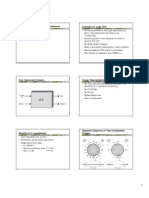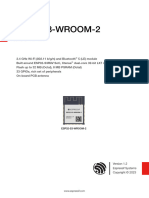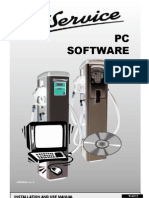Arithmetic: - Performance (Seconds, Cycles, Instructions) - Abstractions
Arithmetic: - Performance (Seconds, Cycles, Instructions) - Abstractions
Uploaded by
anand_duraiswamyCopyright:
Available Formats
Arithmetic: - Performance (Seconds, Cycles, Instructions) - Abstractions
Arithmetic: - Performance (Seconds, Cycles, Instructions) - Abstractions
Uploaded by
anand_duraiswamyOriginal Description:
Original Title
Copyright
Available Formats
Share this document
Did you find this document useful?
Is this content inappropriate?
Copyright:
Available Formats
Arithmetic: - Performance (Seconds, Cycles, Instructions) - Abstractions
Arithmetic: - Performance (Seconds, Cycles, Instructions) - Abstractions
Uploaded by
anand_duraiswamyCopyright:
Available Formats
Arithmetic
• Where we’ve been:
– Performance (seconds, cycles, instructions)
– Abstractions:
Instruction Set Architecture
Assembly Language and Machine Language
• What’s up ahead:
– Implementing the Architecture
operation
a
32 ALU
result
32
b
32
1998 Morgan Kaufmann Publishers 64
Numbers
• Bits are just bits (no inherent meaning)
— conventions define relationship between bits and numbers
• Binary numbers (base 2)
0000 0001 0010 0011 0100 0101 0110 0111 1000 1001...
decimal: 0...2n-1
• Of course it gets more complicated:
numbers are finite (overflow)
fractions and real numbers
negative numbers
e.g., no MIPS subi instruction; addi can add a negative number)
• How do we represent negative numbers?
i.e., which bit patterns will represent which numbers?
1998 Morgan Kaufmann Publishers 65
Possible Representations
• Sign Magnitude: One’s Complement Two’s Complement
000 = +0 000 = +0 000 = +0
001 = +1 001 = +1 001 = +1
010 = +2 010 = +2 010 = +2
011 = +3 011 = +3 011 = +3
100 = -0 100 = -3 100 = -4
101 = -1 101 = -2 101 = -3
110 = -2 110 = -1 110 = -2
111 = -3 111 = -0 111 = -1
• Issues: balance, number of zeros, ease of operations
• Which one is best? Why?
1998 Morgan Kaufmann Publishers 66
MIPS
• 32 bit signed numbers:
0000 0000 0000 0000 0000 0000 0000 0000two = 0ten
0000 0000 0000 0000 0000 0000 0000 0001two = + 1ten
0000 0000 0000 0000 0000 0000 0000 0010two = + 2ten
...
0111 1111 1111 1111 1111 1111 1111 1110two = + 2,147,483,646ten maxint
0111 1111 1111 1111 1111 1111 1111 1111two = + 2,147,483,647ten
1000 0000 0000 0000 0000 0000 0000 0000two = – 2,147,483,648ten
1000 0000 0000 0000 0000 0000 0000 0001two = – 2,147,483,647ten minint
1000 0000 0000 0000 0000 0000 0000 0010two = – 2,147,483,646ten
...
1111 1111 1111 1111 1111 1111 1111 1101two = – 3ten
1111 1111 1111 1111 1111 1111 1111 1110two = – 2ten
1111 1111 1111 1111 1111 1111 1111 1111two = – 1ten
1998 Morgan Kaufmann Publishers 67
Two’s Complement Operations
• Negating a two’s complement number: invert all bits and add 1
– remember: “negate” and “invert” are quite different!
• Converting n bit numbers into numbers with more than n bits:
– MIPS 16 bit immediate gets converted to 32 bits for arithmetic
– copy the most significant bit (the sign bit) into the other bits
0010 -> 0000 0010
1010 -> 1111 1010
– "sign extension" (lbu vs. lb)
1998 Morgan Kaufmann Publishers 68
Addition & Subtraction
• Just like in grade school (carry/borrow 1s)
0111 0111 0110
+ 0110 - 0110 - 0101
• Two’s complement operations easy
– subtraction using addition of negative numbers
0111
+ 1010
• Overflow (result too large for finite computer word):
– e.g., adding two n-bit numbers does not yield an n-bit number
0111
+ 0001 note that overflow term is somewhat misleading,
1000 it does not mean a carry “overflowed”
1998 Morgan Kaufmann Publishers 69
Detecting Overflow
• No overflow when adding a positive and a negative number
• No overflow when signs are the same for subtraction
• Overflow occurs when the value affects the sign:
– overflow when adding two positives yields a negative
– or, adding two negatives gives a positive
– or, subtract a negative from a positive and get a negative
– or, subtract a positive from a negative and get a positive
• Consider the operations A + B, and A – B
– Can overflow occur if B is 0 ?
– Can overflow occur if A is 0 ?
1998 Morgan Kaufmann Publishers 70
Effects of Overflow
• An exception (interrupt) occurs
– Control jumps to predefined address for exception
– Interrupted address is saved for possible resumption
• Details based on software system / language
– example: flight control vs. homework assignment
• Don’t always want to detect overflow
— new MIPS instructions: addu, addiu, subu
note: addiu still sign-extends!
note: sltu, sltiu for unsigned comparisons
1998 Morgan Kaufmann Publishers 71
Review: Boolean Algebra & Gates
• Problem: Consider a logic function with three inputs: A, B, and C.
Output D is true if at least one input is true
Output E is true if exactly two inputs are true
Output F is true only if all three inputs are true
• Show the truth table for these three functions.
• Show the Boolean equations for these three functions.
• Show an implementation consisting of inverters, AND, and OR gates.
1998 Morgan Kaufmann Publishers 72
An ALU (arithmetic logic unit)
• Let’s build an ALU to support the andi and ori instructions
– we’ll just build a 1 bit ALU, and use 32 of them
operation op a b res
a result
b
• Possible Implementation (sum-of-products):
1998 Morgan Kaufmann Publishers 73
Review: The Multiplexor
• Selects one of the inputs to be the output, based on a control input
S
note: we call this a 2-input mux
A 0 even though it has 3 inputs!
C
B 1
• Lets build our ALU using a MUX:
1998 Morgan Kaufmann Publishers 74
Different Implementations
• Not easy to decide the “best” way to build something
– Don’t want too many inputs to a single gate
– Dont want to have to go through too many gates
– for our purposes, ease of comprehension is important
• Let’s look at a 1-bit ALU for addition:
CarryIn
a
cout = a b + a cin + b cin
Sum
sum = a xor b xor cin
b
CarryOut
• How could we build a 1-bit ALU for add, and, and or?
• How could we build a 32-bit ALU?
1998 Morgan Kaufmann Publishers 75
Building a 32 bit ALU
CarryIn Operation
a0 CarryIn
Result0
ALU0
b0
CarryOut
Operation
CarryIn
a1 CarryIn
a Result1
0 ALU1
b1
CarryOut
1
Result
a2 CarryIn
Result2
2 ALU2
b2
b
CarryOut
CarryOut
a31 CarryIn
Result31
ALU31
b31
1998 Morgan Kaufmann Publishers 76
What about subtraction (a – b) ?
• Two’s complement approch: just negate b and add.
• How do we negate?
• A very clever solution:
Binvert Operation
CarryIn
a
0
1
Result
b 0 2
CarryOut
1998 Morgan Kaufmann Publishers 77
You might also like
- Ericsson Mini Link TN MGMT Operation and MaintenanceDocument28 pagesEricsson Mini Link TN MGMT Operation and Maintenancesaidbitar100% (13)
- CPSC 161: Prof. L.N. Bhuyan .HTMLDocument28 pagesCPSC 161: Prof. L.N. Bhuyan .HTMLShyamala RamachandranNo ratings yet
- Chapter 3 Arithmetic For Computers (Revised)Document64 pagesChapter 3 Arithmetic For Computers (Revised)yrikkiNo ratings yet
- CS M151B / EE M116C: Computer Systems ArchitectureDocument33 pagesCS M151B / EE M116C: Computer Systems ArchitecturetinhtrilacNo ratings yet
- 2.1 Addtion&subtractionDocument42 pages2.1 Addtion&subtractionGireesh DgNo ratings yet
- Unit 5Document46 pagesUnit 5dutta chNo ratings yet
- Notes 9Document10 pagesNotes 9HAMNA KAHLUNo ratings yet
- Week9 2Document48 pagesWeek9 2Souvik DasNo ratings yet
- Chapter IV Computer ArithmeticDocument133 pagesChapter IV Computer Arithmeticsr23shubhiNo ratings yet
- Lecture 8: Binary Multiplication & DivisionDocument20 pagesLecture 8: Binary Multiplication & DivisionAfnanNo ratings yet
- 10-Floating Point Representation With IEEE Standards and Algorithms For Common Arithmetic operations-30-Jul-2019Material - IDocument34 pages10-Floating Point Representation With IEEE Standards and Algorithms For Common Arithmetic operations-30-Jul-2019Material - Ividhi agarwalNo ratings yet
- FALLSEM2019-20 CSE2001 TH VL2019201000585 Reference Material I 13-Aug-2019 Data Representation and Computer Arithmetic 2019 2010Document34 pagesFALLSEM2019-20 CSE2001 TH VL2019201000585 Reference Material I 13-Aug-2019 Data Representation and Computer Arithmetic 2019 2010Puneeth SaiNo ratings yet
- Lecture 8: Binary Multiplication & DivisionDocument20 pagesLecture 8: Binary Multiplication & DivisionTahir KhanNo ratings yet
- Study Material For Lecture 4Document12 pagesStudy Material For Lecture 4Aviral UpadhyayNo ratings yet
- Chapter IV Computer ArithmeticDocument133 pagesChapter IV Computer ArithmeticjohnsamvlbNo ratings yet
- BiD 09Document56 pagesBiD 09mehmetNo ratings yet
- Computer Organization & Assembly Language: CS/COE0447Document30 pagesComputer Organization & Assembly Language: CS/COE0447Danilo AlbayNo ratings yet
- Mips AluDocument27 pagesMips AluoromosNo ratings yet
- Logic Synthesis at MITDocument8 pagesLogic Synthesis at MITkumarguptav91No ratings yet
- MIPS Architecture - BITS PilaniDocument58 pagesMIPS Architecture - BITS PilaniMIHIKA PARAG DESHPANDENo ratings yet
- Computer Arithmetic: Multiplication Algorithms Division Algorithms Floating-Point Arithmetic OperationsDocument70 pagesComputer Arithmetic: Multiplication Algorithms Division Algorithms Floating-Point Arithmetic Operationsanubhavseth56No ratings yet
- CH 04Document90 pagesCH 04rigop58682No ratings yet
- Arithmetic & Logic UnitDocument58 pagesArithmetic & Logic Unitakbisoi1No ratings yet
- Lecture#6Document54 pagesLecture#6muhammadaliasghar905No ratings yet
- Ch2 - Lec1 - Computer ArithmeticDocument36 pagesCh2 - Lec1 - Computer ArithmeticMagarsaa Qana'iiNo ratings yet
- CS M151B / EE M116C: Computer Systems ArchitectureDocument29 pagesCS M151B / EE M116C: Computer Systems ArchitecturetinhtrilacNo ratings yet
- CODch 4 SlidesDocument71 pagesCODch 4 SlidesborhanNo ratings yet
- 21csf05 - Coa - Unit 2Document47 pages21csf05 - Coa - Unit 2mmahesh87656No ratings yet
- Chapter 1 (Data Representation)Document74 pagesChapter 1 (Data Representation)whtet6933No ratings yet
- CO221 KBS3 Boolean AlgebraDocument21 pagesCO221 KBS3 Boolean Algebraravindulakshan.rl2002No ratings yet
- Adder CircuitsDocument26 pagesAdder CircuitsAnkur JhaNo ratings yet
- Processor Design 5Z032: Arithmetic For ComputersDocument57 pagesProcessor Design 5Z032: Arithmetic For ComputersdishatiwariNo ratings yet
- Lecture 8: Binary Multiplication & DivisionDocument20 pagesLecture 8: Binary Multiplication & DivisionPhillip BuchananNo ratings yet
- 4 - Bit - Carry - Propagate - Adder PDFDocument32 pages4 - Bit - Carry - Propagate - Adder PDFSubhajit DasNo ratings yet
- Role of The Compiler - Take QUIZ 5 Before 11:59pm Today Over Chapter 3 Readings - Topics - Number Representations - Computer ArithmeticDocument12 pagesRole of The Compiler - Take QUIZ 5 Before 11:59pm Today Over Chapter 3 Readings - Topics - Number Representations - Computer ArithmeticFazal JadoonNo ratings yet
- Chapter 3Document72 pagesChapter 3john MGNo ratings yet
- Design A Fast ALU For The MIPS ISA - Requirements ?Document71 pagesDesign A Fast ALU For The MIPS ISA - Requirements ?thanhvnptNo ratings yet
- 7 - Binary Addition and SubtractionDocument41 pages7 - Binary Addition and SubtractionKarthi KNo ratings yet
- The Design Process & ALU DesignDocument6 pagesThe Design Process & ALU DesignNarender KumarNo ratings yet
- DigitalLogic ComputerOrganization L13 Arithmetic HandoutDocument37 pagesDigitalLogic ComputerOrganization L13 Arithmetic HandoutPhan Tuấn KhôiNo ratings yet
- 9 Computer ArithmeticsDocument47 pages9 Computer ArithmeticsBomber KillerNo ratings yet
- Fundamental of Computer Science: Subject code-IMIT-1101Document48 pagesFundamental of Computer Science: Subject code-IMIT-1101hissoulyt1No ratings yet
- Coa Paper Winter 2022Document16 pagesCoa Paper Winter 2022PRABHNo ratings yet
- Computer Organization and Architecture Arithmetic & Logic UnitDocument12 pagesComputer Organization and Architecture Arithmetic & Logic UnitMohammed BilalNo ratings yet
- Baughwooly MultiplierDocument65 pagesBaughwooly MultipliermiguelNo ratings yet
- Vishal BoothDocument12 pagesVishal BoothKishor SarawadekarNo ratings yet
- 09 ArithmeticDocument41 pages09 ArithmeticEva WilizNo ratings yet
- This Unit: Arithmetic and ALU Design ShiftsDocument8 pagesThis Unit: Arithmetic and ALU Design ShiftsBhagya RajuNo ratings yet
- COD Ch. 3 Arithmetic For ComputersDocument72 pagesCOD Ch. 3 Arithmetic For ComputersMohammad Abdul RafehNo ratings yet
- COD - Unit-3 - N - 4 - PPT AJAY KumarDocument93 pagesCOD - Unit-3 - N - 4 - PPT AJAY KumarAjay KumarNo ratings yet
- Computer Organization and Architecture: Central Processing Unit Computer ArithmeticDocument30 pagesComputer Organization and Architecture: Central Processing Unit Computer ArithmeticZersh EthioNo ratings yet
- DLD3Document9 pagesDLD3rasoolaamir99No ratings yet
- Pooja VashisthDocument51 pagesPooja VashisthApurva SinghNo ratings yet
- Chapter - 6 Digital ElectronicsDocument75 pagesChapter - 6 Digital ElectronicsAnish PaudelNo ratings yet
- Assignment #03: Submitted byDocument7 pagesAssignment #03: Submitted byMUHAMMAD ABDULLAHNo ratings yet
- The Definitive Guide to How Computers Do Math: Featuring the Virtual DIY CalculatorFrom EverandThe Definitive Guide to How Computers Do Math: Featuring the Virtual DIY CalculatorNo ratings yet
- Let's Practise: Maths Workbook Coursebook 7From EverandLet's Practise: Maths Workbook Coursebook 7No ratings yet
- AP Calculus Flashcards, Fourth Edition: Up-to-Date Review and PracticeFrom EverandAP Calculus Flashcards, Fourth Edition: Up-to-Date Review and PracticeNo ratings yet
- Multiplication: - Accomplished Via Shifting and AdditionDocument4 pagesMultiplication: - Accomplished Via Shifting and Additionanand_duraiswamyNo ratings yet
- TQM 2 and 16 Marks PDFDocument127 pagesTQM 2 and 16 Marks PDFanand_duraiswamyNo ratings yet
- Iot Agriculture System Based On Lorawan: Danco Davcev, Kosta Mitreski, Stefan Trajkovic, Viktor Nikolovski, Nikola KoteliDocument4 pagesIot Agriculture System Based On Lorawan: Danco Davcev, Kosta Mitreski, Stefan Trajkovic, Viktor Nikolovski, Nikola Kotelianand_duraiswamyNo ratings yet
- Our AbstractDocument2 pagesOur Abstractanand_duraiswamyNo ratings yet
- CH01 Solution PDFDocument8 pagesCH01 Solution PDFanand_duraiswamyNo ratings yet
- Control: - Alter The Control Flow, - I.e., Change The "Next" Instruction To Be ExecutedDocument9 pagesControl: - Alter The Control Flow, - I.e., Change The "Next" Instruction To Be Executedanand_duraiswamyNo ratings yet
- Instructions:: Design Goals: Maximize Performance and Minimize Cost, Reduce Design TimeDocument7 pagesInstructions:: Design Goals: Maximize Performance and Minimize Cost, Reduce Design Timeanand_duraiswamyNo ratings yet
- Cpu - Memory (Disk Drives, DRAM, SRAM, CD) - Input (Mouse, Keyboard) - Output (Display, Printer) - Network - SoftwareDocument14 pagesCpu - Memory (Disk Drives, DRAM, SRAM, CD) - Input (Mouse, Keyboard) - Output (Display, Printer) - Network - Softwareanand_duraiswamyNo ratings yet
- 32bitsinglecycleprocessor PDFDocument18 pages32bitsinglecycleprocessor PDFanand_duraiswamy100% (1)
- VLSI Lab Viva Questions and Answers 1Document21 pagesVLSI Lab Viva Questions and Answers 1anand_duraiswamy0% (1)
- Rules and Regulations ADC2018Document2 pagesRules and Regulations ADC2018anand_duraiswamyNo ratings yet
- EC6612 VLSI DESIGN Laboratory Question SetDocument6 pagesEC6612 VLSI DESIGN Laboratory Question Setanand_duraiswamyNo ratings yet
- EC2 Mark Splitup 2017Document6 pagesEC2 Mark Splitup 2017anand_duraiswamyNo ratings yet
- Implementing Interrupt in Arm ProcessorDocument4 pagesImplementing Interrupt in Arm Processoranand_duraiswamyNo ratings yet
- EC2 Mark Splitup 2017Document9 pagesEC2 Mark Splitup 2017anand_duraiswamyNo ratings yet
- Anna University Practical Examination Dec-2014 Semester: Iv Sem Subject Code/Name: Ec6412 / Lic Lab DATE OF EXAM: 17.04.17 Time: 9:00AM To 12:00PMDocument1 pageAnna University Practical Examination Dec-2014 Semester: Iv Sem Subject Code/Name: Ec6412 / Lic Lab DATE OF EXAM: 17.04.17 Time: 9:00AM To 12:00PManand_duraiswamyNo ratings yet
- VLSI Design - VerilogDocument30 pagesVLSI Design - Veriloganand_duraiswamyNo ratings yet
- C Pointers Fundamentals Explained With ExamplesDocument16 pagesC Pointers Fundamentals Explained With Examplesanand_duraiswamyNo ratings yet
- Embedded System Lab Non-Recurring Register Embedded System Lab Recurring RegisterDocument2 pagesEmbedded System Lab Non-Recurring Register Embedded System Lab Recurring Registeranand_duraiswamyNo ratings yet
- User Guide: 75, 705, 7540, 7600 and 7650 Series CRT MonitorsDocument44 pagesUser Guide: 75, 705, 7540, 7600 and 7650 Series CRT MonitorsdennidavistNo ratings yet
- Eti Micro ProjectDocument15 pagesEti Micro ProjectRed Light HackersNo ratings yet
- Hitachi Power Grids Semis 3phase 3level Igbt Usermanual 5SYA2117 05Document26 pagesHitachi Power Grids Semis 3phase 3level Igbt Usermanual 5SYA2117 05Cao Đức HuyNo ratings yet
- Series and Parallelcircuits LabDocument3 pagesSeries and Parallelcircuits LabmadisonsjbddbNo ratings yet
- hw1 11 12 13 16 31 12 33 PDFDocument7 pageshw1 11 12 13 16 31 12 33 PDFNguyễn Thành HiệpNo ratings yet
- System Monitoring Engineer - JDDocument2 pagesSystem Monitoring Engineer - JDismail taifNo ratings yet
- CSTE Sample Question Papers-Part 1Document51 pagesCSTE Sample Question Papers-Part 1api-26796007100% (2)
- 3.2.4.4 H83DSDMM: Functions and SpecificationsDocument4 pages3.2.4.4 H83DSDMM: Functions and SpecificationsAlexander PischulinNo ratings yet
- Cloud ComputingDocument29 pagesCloud Computingtanishq_5774371100% (2)
- 4 - Penguat Tak MembalikDocument10 pages4 - Penguat Tak MembalikFaizNo ratings yet
- Landmine DetectionDocument87 pagesLandmine DetectionmgitecetechNo ratings yet
- 1.2.1. Variables (1) - Jupyter NotebookDocument6 pages1.2.1. Variables (1) - Jupyter NotebookChaitanya ParaleNo ratings yet
- Notebook Toshiba Satellite L675 EsquematicoDocument53 pagesNotebook Toshiba Satellite L675 EsquematicoRonny Kimer Fiestas Vargas100% (1)
- HCL TechnologiesDocument5 pagesHCL TechnologiesThulasi RamNo ratings yet
- Rimatrix5 Chiller New SW ManagementDocument31 pagesRimatrix5 Chiller New SW ManagementJavier CandarabeNo ratings yet
- Activity 3.1.5 Variables & Functions VEX V5 2021Document12 pagesActivity 3.1.5 Variables & Functions VEX V5 2021Kidus FissehaNo ratings yet
- CP1H Function BlocksDocument59 pagesCP1H Function BlocksSérgio Cardoso de OliveiraNo ratings yet
- ExtendedDocument124 pagesExtendedKoke2301No ratings yet
- Lisensi Office 365Document1 pageLisensi Office 365MUFA RIJFANo ratings yet
- K To 12 PC Hardware Servicing Learning ModuleDocument139 pagesK To 12 PC Hardware Servicing Learning ModuleLady Antoniette M. BonggotNo ratings yet
- ATEasy8ProgrammingLanguage PDFDocument0 pagesATEasy8ProgrammingLanguage PDFnova debussy100% (2)
- Esp32 s3 Wroom 2 - Datasheet - enDocument36 pagesEsp32 s3 Wroom 2 - Datasheet - enjasonm212No ratings yet
- Java InterfaceDocument7 pagesJava InterfaceYash PatilNo ratings yet
- Tuning Your Drive For SuccessDocument3 pagesTuning Your Drive For SuccessThiago AraujoNo ratings yet
- BMC Remedy ITSM 9.1.02 PDFDocument2,047 pagesBMC Remedy ITSM 9.1.02 PDFIRINA BRANNo ratings yet
- EC-520 User's ManualDocument41 pagesEC-520 User's ManualJorge OrnelasNo ratings yet
- M0090-UK Rev 5Document28 pagesM0090-UK Rev 5kjhobsonNo ratings yet
- Hardware in Loop SimulationDocument12 pagesHardware in Loop Simulationmullig86No ratings yet
- OpenDCL Tutorial NovoDocument20 pagesOpenDCL Tutorial NovoautotopoNo ratings yet












































































































